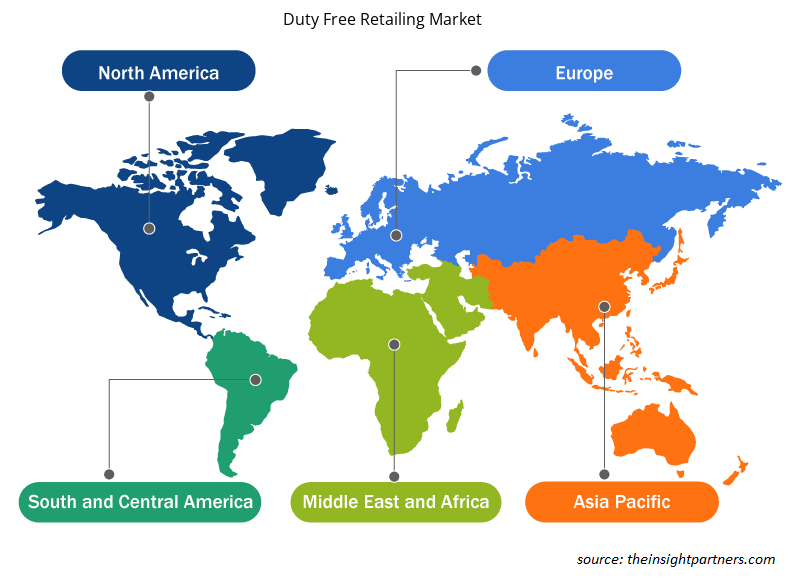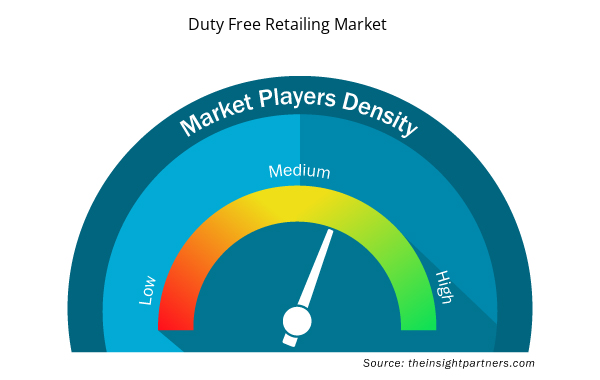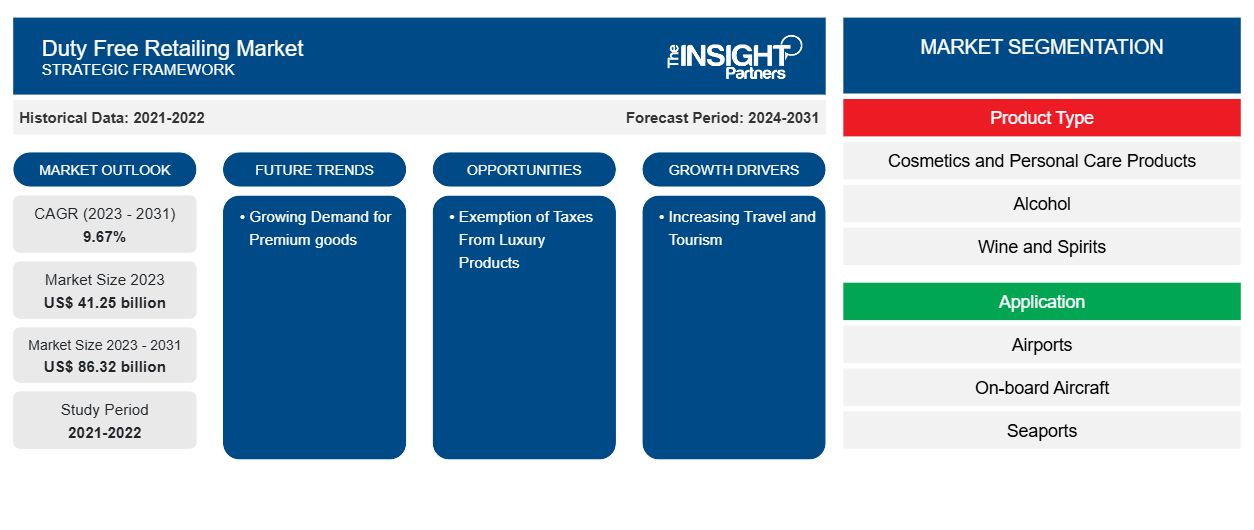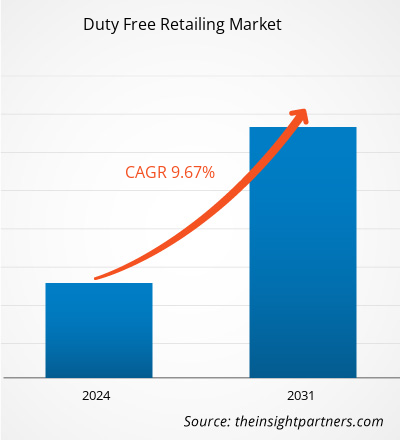Der Duty-Free-Einzelhandelsmarkt soll von 41,25 Milliarden US-Dollar im Jahr 2023 auf 86,32 Milliarden US-Dollar im Jahr 2031 anwachsen. Der Duty-Free-Einzelhandelsmarkt soll in den Jahren 2023–2031 eine durchschnittliche jährliche Wachstumsrate (CAGR) von 9,67 % verzeichnen. Der zunehmende Rückgang von Luxusprodukten und One-Stop-Shopping.
Duty-Free-Einzelhandel-Marktanalyse
Wachsende Investitionen und Entwicklung der Reise- und Tourismusbranche, gepaart mit der Integration von Segmenten wie Gastgewerbe und Infrastruktur mit staatlicher Unterstützung zur Förderung der Reise- und Tourismusbranche , führen zum Wachstum des Duty-Free-Einzelhandelsmarktes.
Überblick über den Duty-Free-Einzelhandelsmarkt
Der Duty-Free-Shop bezieht sich auf Verkaufsstellen, die Waren anbieten, die von der Zahlung bestimmter nationaler und lokaler Steuern befreit sind. Diese Steuerbefreiung senkt die Preise im Vergleich zu normalen Einzelhandelsgeschäften. Duty-Free-Verkaufsstellen bieten Reisenden die Möglichkeit, bei verschiedenen Produkten wie Alkohol, Parfüm, Tabak, Kosmetika, Elektronik und vielem mehr Geld zu sparen. Die Ersparnis kann erheblich sein, insbesondere bei teuren Luxusartikeln. Diese Duty-Free-Shops sind strategisch günstig in den Terminals internationaler Flughäfen gelegen, sodass sie für Reisende, die aus anderen Ländern abfliegen oder ankommen, leicht zugänglich sind. Wenn Passagiere also Dinge einkaufen möchten, die sie während ihrer Reise benötigen, oder Souvenirs und Geschenke für Freunde und Familie kaufen möchten, können sie dies problemlos in diesen Duty-Free-Shops tun.
Passen Sie diesen Bericht Ihren Anforderungen an
Sie erhalten kostenlose Anpassungen an jedem Bericht, einschließlich Teilen dieses Berichts oder einer Analyse auf Länderebene, eines Excel-Datenpakets sowie tolle Angebote und Rabatte für Start-ups und Universitäten.
- Holen Sie sich die wichtigsten Markttrends aus diesem Bericht.Dieses KOSTENLOSE Beispiel umfasst eine Datenanalyse von Markttrends bis hin zu Schätzungen und Prognosen.
Treiber und Chancen im Duty-Free-Einzelhandel
Steuerbefreiung für Luxusgüter soll den Markt begünstigen
Die zollfreien Artikel ermöglichen es den Verbrauchern, Luxus- und High-End-Waren zu zollfreien Preisen zu erwerben. Bei einem hektischen Lebensstil bevorzugen die Verbraucher das One-Stop-Shopping, und ein solcher zollfreier Einzelhandel hilft ihnen, besser und luxuriöser einzukaufen. Luxusgüter wie Parfüms, Uhren, Zigarren, hochwertiger Alkohol, Modeschmuck und andere sind die attraktivsten Artikel in Duty-Free-Shops zu günstigeren Preisen, was die Verbraucher anzieht. Darüber hinaus eröffnen verschiedene Länder zollfreie Luxus-Einzelhandelsgeschäfte. So eröffnete beispielsweise im November 2021 Louis Vuitton, ein zollfreies Luxusartikelgeschäft, auf der Luxusinsel Hainan. Diese Neigung zu zollfreien Luxusprodukten treibt also das Wachstum des Duty-Free-Einzelhandelsmarktes voran.
Zunehmendes Reisen und Tourismus
Laut dem ersten Welttourismusbarometer der Welthandelsorganisation der Vereinten Nationen (UNWTO) des Jahres lag der internationale Tourismus 2023 bei 88 %, mit geschätzten 1,3 Milliarden internationalen Ankünften. Das neueste UNWTO-Welttourismusbarometer bietet einen vollständigen Überblick über die Leistung des Sektors im Jahr 2023 und zeichnet die Erholung nach globalen Regionen, Unterregionen und Reisezielen nach. Die internationalen Tourismuseinnahmen erreichten im Jahr 2023 vorläufigen Schätzungen zufolge 1,4 Billionen US-Dollar. Darüber hinaus wird der chinesische Aus- und Einreisetourismus im Jahr 2024 voraussichtlich aufgrund von Visaerleichterungen und verbesserten Flugkapazitäten zunehmen. China beantragt die visumfreie Einreise für Bürger aus Frankreich, Italien, Deutschland, den Niederlanden, Spanien und Malaysia für ein Jahr bis zum 30. November 2024. Europa wird voraussichtlich 2024 erneut die Nase vorn haben. Im März traten Rumänien und Bulgarien dem Schengen-Raum bei und Paris wird im Juli und August 2024 Gastgeber der Olympischen Sommerspiele sein. Solche Erleichterungen für zunehmendes Reisen und Tourismus werden das internationale Reisen ankurbeln, was Möglichkeiten für das Wachstum des Duty-Free-Einzelhandelsmarktes schafft.
Duty-Free-Einzelhandel-Marktbericht Segmentierungsanalyse
Wichtige Segmente, die zur Ableitung der Analyse des Duty-Free-Einzelhandelsmarktes beigetragen haben, sind Produkttyp und Anwendung.
- Basierend auf dem Produkttyp ist der Duty-Free-Einzelhandelsmarkt in Kosmetika und Körperpflegeprodukte, Alkohol, Wein und Spirituosen, Tabak und Zigaretten, Mode, Süßwaren und Lebensmittel und Sonstiges unterteilt.
- Basierend auf der Anwendung ist der Duty-Free-Einzelhandelsmarkt in Flughäfen, Flugzeuge, Seehäfen und andere segmentiert.
Duty-Free-Einzelhandel Marktanteilsanalyse nach Geografie
Der geografische Umfang des Berichts zum Duty-Free-Einzelhandelsmarkt ist hauptsächlich in fünf Regionen unterteilt: Nordamerika, Asien-Pazifik, Europa, Naher Osten und Afrika sowie Südamerika/Süd- und Mittelamerika. Der globale Duty-Free-Einzelhandel mit zunehmendem Reise- und Tourismusverkehr und Wachstum der Flughafeninfrastruktur. Im August 2023 prognostizierte Airports Council International (ACI) World ein durchschnittliches jährliches Wachstum des Passagierverkehrs von 5,8 % zwischen 2022 und 2040. Bis 2040 werden jährlich mehr als 19 Milliarden Passagiere über Flughäfen weltweit reisen. Im November 2023 berichtete Airport Council International, dass die Region Asien-Pazifik ein erhebliches Potenzial für die Luftfahrt hat, da 57 % der 300 geplanten Flughäfen weltweit in dieser Region entstehen. Ein solches Wachstum bei Flughäfen und Passagierverkehr schafft also eine lukrative Gelegenheit für das Wachstum des Duty-Free-Einzelhandelsmarktes.
Regionale Einblicke in den Duty-Free-Einzelhandelsmarkt
Die regionalen Trends und Faktoren, die den Duty-Free-Einzelhandelsmarkt während des Prognosezeitraums beeinflussen, wurden von den Analysten von Insight Partners ausführlich erläutert. In diesem Abschnitt werden auch die Marktsegmente und die Geografie des Duty-Free-Einzelhandels in Nordamerika, Europa, im asiatisch-pazifischen Raum, im Nahen Osten und Afrika sowie in Süd- und Mittelamerika erörtert.

- Erhalten Sie regionale Daten zum Duty-Free-Einzelhandelsmarkt
Umfang des Duty-Free-Einzelhandelsmarktberichts
| Berichtsattribut | Details |
|---|---|
| Marktgröße im Jahr 2023 | 41,25 Milliarden US-Dollar |
| Marktgröße bis 2031 | 86,32 Milliarden US-Dollar |
| Globale CAGR (2023 - 2031) | 9,67 % |
| Historische Daten | 2021-2022 |
| Prognosezeitraum | 2024–2031 |
| Abgedeckte Segmente | Nach Produkttyp
|
| Abgedeckte Regionen und Länder | Nordamerika
|
| Marktführer und wichtige Unternehmensprofile |
|
Dichte der Akteure im Duty-Free-Einzelhandel: Die Auswirkungen auf die Geschäftsdynamik verstehen
Der Duty-Free-Einzelhandelsmarkt wächst rasant, angetrieben von der steigenden Nachfrage der Endverbraucher aufgrund von Faktoren wie sich entwickelnden Verbraucherpräferenzen, technologischen Fortschritten und einem größeren Bewusstsein für die Vorteile des Produkts. Mit steigender Nachfrage erweitern Unternehmen ihr Angebot, entwickeln Innovationen, um die Bedürfnisse der Verbraucher zu erfüllen, und nutzen neue Trends, was das Marktwachstum weiter ankurbelt.
Die Marktteilnehmerdichte bezieht sich auf die Verteilung der Firmen oder Unternehmen, die in einem bestimmten Markt oder einer bestimmten Branche tätig sind. Sie gibt an, wie viele Wettbewerber (Marktteilnehmer) in einem bestimmten Marktraum im Verhältnis zu seiner Größe oder seinem gesamten Marktwert präsent sind.
Die wichtigsten Unternehmen auf dem Duty-Free-Einzelhandelsmarkt sind:
- Aer Rianta International (ARI)
- China Duty-Free-Gruppe Co., Ltd.
- Dubai Duty-Free
- Duty-Free-Shops in Amerika
- Gebr. Heinemann
- King Power International Gruppe
Haftungsausschluss : Die oben aufgeführten Unternehmen sind nicht in einer bestimmten Reihenfolge aufgeführt.

- Erhalten Sie einen Überblick über die wichtigsten Akteure auf dem Duty-Free-Einzelhandelsmarkt
Neuigkeiten und aktuelle Entwicklungen im Duty-Free-Einzelhandelsmarkt
Der Duty-Free-Einzelhandelsmarkt wird durch die Erhebung qualitativer und quantitativer Daten nach Primär- und Sekundärforschung bewertet, die wichtige Unternehmensveröffentlichungen, Verbandsdaten und Datenbanken einbezieht. Im Folgenden finden Sie eine Liste der Entwicklungen auf dem Markt:
- Im März 2024 gab Mumbai Travel Retail Private Limited (MTRPL) seine Umbenennung in OSPREE bekannt. Die neue Markenidentität „Ospree“ dient als Strategie von MTRPL zur Integration aller Duty-Free-Beteiligungen, darunter Mumbai, Amritsar, Lucknow, Thiruvananthapuram, Jaipur, Ahmedabad und Mangalore.
(Quelle: Mumbai Travel Retail Private Limited, Pressemitteilung, 2024)
- Im Januar 2024 kündigte Mumbai Duty Free einen Nappa Dori-Store im Abflugbereich des Chhatrapati Shivaji Maharaj International Airport an und markierte damit den Einstieg der Marke in den Reiseeinzelhandel. Nappa Dori, was übersetzt Leder und Faden bedeutet, ist eine Marke indischen Ursprungs, die für ihre handgefertigten Lederwaren und Accessoires bekannt ist.
(Quelle: Mumbai Duty Free, Pressemitteilung, 2024)
Bericht zum Duty-Free-Einzelhandelsmarkt: Umfang und Ergebnisse
Der Bericht „Duty-Free-Einzelhandel – Marktgröße und -prognose (2021–2031)“ bietet eine detaillierte Analyse des Marktes, die die folgenden Bereiche abdeckt:
- Marktgröße und Prognose auf globaler, regionaler und Länderebene für alle wichtigen Marktsegmente, die im Rahmen des Projekts abgedeckt sind
- Marktdynamik wie Treiber, Beschränkungen und wichtige Chancen
- Wichtige Zukunftstrends
- Detaillierte PEST/Porters Five Forces- und SWOT-Analyse
- Globale und regionale Marktanalyse mit wichtigen Markttrends, wichtigen Akteuren, Vorschriften und aktuellen Marktentwicklungen
- Branchenlandschaft und Wettbewerbsanalyse, einschließlich Marktkonzentration, Heatmap-Analyse, prominenten Akteuren und aktuellen Entwicklungen
- Detaillierte Firmenprofile
- Historische Analyse (2 Jahre), Basisjahr, Prognose (7 Jahre) mit CAGR
- PEST- und SWOT-Analyse
- Marktgröße Wert/Volumen – Global, Regional, Land
- Branche und Wettbewerbsumfeld
- Excel-Datensatz



Report Coverage
Revenue forecast, Company Analysis, Industry landscape, Growth factors, and Trends

Segment Covered
This text is related
to segments covered.

Regional Scope
North America, Europe, Asia Pacific, Middle East & Africa, South & Central America

Country Scope
This text is related
to country scope.
Häufig gestellte Fragen
The global duty free retailing market was estimated to be US$ 41.25 billion in 2023 and is expected to grow at a CAGR of 9.67% during the forecast period 2023 - 2031.
Exemption of taxes from luxury products is the major factors that propel the global duty free retailing market.
Growing demand for premium goods is anticipated to play a significant role in the global duty free retailing market in the coming years.
The key players holding majority shares in the global duty free retailing market Aer Rianta International (ARI), China Duty Free Group Co., Ltd., Dubai Duty Free, Duty Free Americas, and Gebr. Heinemann.
The global duty free retailing market is expected to reach US$ 86.32 billion by 2031.
Trends and growth analysis reports related to Technology, Media and Telecommunications : READ MORE..
The Insight Partners performs research in 4 major stages: Data Collection & Secondary Research, Primary Research, Data Analysis and Data Triangulation & Final Review.
- Data Collection and Secondary Research:
As a market research and consulting firm operating from a decade, we have published and advised several client across the globe. First step for any study will start with an assessment of currently available data and insights from existing reports. Further, historical and current market information is collected from Investor Presentations, Annual Reports, SEC Filings, etc., and other information related to company’s performance and market positioning are gathered from Paid Databases (Factiva, Hoovers, and Reuters) and various other publications available in public domain.
Several associations trade associates, technical forums, institutes, societies and organization are accessed to gain technical as well as market related insights through their publications such as research papers, blogs and press releases related to the studies are referred to get cues about the market. Further, white papers, journals, magazines, and other news articles published in last 3 years are scrutinized and analyzed to understand the current market trends.
- Primary Research:
The primarily interview analysis comprise of data obtained from industry participants interview and answers to survey questions gathered by in-house primary team.
For primary research, interviews are conducted with industry experts/CEOs/Marketing Managers/VPs/Subject Matter Experts from both demand and supply side to get a 360-degree view of the market. The primary team conducts several interviews based on the complexity of the markets to understand the various market trends and dynamics which makes research more credible and precise.
A typical research interview fulfils the following functions:
- Provides first-hand information on the market size, market trends, growth trends, competitive landscape, and outlook
- Validates and strengthens in-house secondary research findings
- Develops the analysis team’s expertise and market understanding
Primary research involves email interactions and telephone interviews for each market, category, segment, and sub-segment across geographies. The participants who typically take part in such a process include, but are not limited to:
- Industry participants: VPs, business development managers, market intelligence managers and national sales managers
- Outside experts: Valuation experts, research analysts and key opinion leaders specializing in the electronics and semiconductor industry.
Below is the breakup of our primary respondents by company, designation, and region:

Once we receive the confirmation from primary research sources or primary respondents, we finalize the base year market estimation and forecast the data as per the macroeconomic and microeconomic factors assessed during data collection.
- Data Analysis:
Once data is validated through both secondary as well as primary respondents, we finalize the market estimations by hypothesis formulation and factor analysis at regional and country level.
- Macro-Economic Factor Analysis:
We analyse macroeconomic indicators such the gross domestic product (GDP), increase in the demand for goods and services across industries, technological advancement, regional economic growth, governmental policies, the influence of COVID-19, PEST analysis, and other aspects. This analysis aids in setting benchmarks for various nations/regions and approximating market splits. Additionally, the general trend of the aforementioned components aid in determining the market's development possibilities.
- Country Level Data:
Various factors that are especially aligned to the country are taken into account to determine the market size for a certain area and country, including the presence of vendors, such as headquarters and offices, the country's GDP, demand patterns, and industry growth. To comprehend the market dynamics for the nation, a number of growth variables, inhibitors, application areas, and current market trends are researched. The aforementioned elements aid in determining the country's overall market's growth potential.
- Company Profile:
The “Table of Contents” is formulated by listing and analyzing more than 25 - 30 companies operating in the market ecosystem across geographies. However, we profile only 10 companies as a standard practice in our syndicate reports. These 10 companies comprise leading, emerging, and regional players. Nonetheless, our analysis is not restricted to the 10 listed companies, we also analyze other companies present in the market to develop a holistic view and understand the prevailing trends. The “Company Profiles” section in the report covers key facts, business description, products & services, financial information, SWOT analysis, and key developments. The financial information presented is extracted from the annual reports and official documents of the publicly listed companies. Upon collecting the information for the sections of respective companies, we verify them via various primary sources and then compile the data in respective company profiles. The company level information helps us in deriving the base number as well as in forecasting the market size.
- Developing Base Number:
Aggregation of sales statistics (2020-2022) and macro-economic factor, and other secondary and primary research insights are utilized to arrive at base number and related market shares for 2022. The data gaps are identified in this step and relevant market data is analyzed, collected from paid primary interviews or databases. On finalizing the base year market size, forecasts are developed on the basis of macro-economic, industry and market growth factors and company level analysis.
- Data Triangulation and Final Review:
The market findings and base year market size calculations are validated from supply as well as demand side. Demand side validations are based on macro-economic factor analysis and benchmarks for respective regions and countries. In case of supply side validations, revenues of major companies are estimated (in case not available) based on industry benchmark, approximate number of employees, product portfolio, and primary interviews revenues are gathered. Further revenue from target product/service segment is assessed to avoid overshooting of market statistics. In case of heavy deviations between supply and demand side values, all thes steps are repeated to achieve synchronization.
We follow an iterative model, wherein we share our research findings with Subject Matter Experts (SME’s) and Key Opinion Leaders (KOLs) until consensus view of the market is not formulated – this model negates any drastic deviation in the opinions of experts. Only validated and universally acceptable research findings are quoted in our reports.
We have important check points that we use to validate our research findings – which we call – data triangulation, where we validate the information, we generate from secondary sources with primary interviews and then we re-validate with our internal data bases and Subject matter experts. This comprehensive model enables us to deliver high quality, reliable data in shortest possible time.


 Holen Sie sich ein kostenloses Muster für diesen Bericht
Holen Sie sich ein kostenloses Muster für diesen Bericht